
The History of Heed Audio
The Heed Evolution Heed Audio Ltd is a specialist hi-fi manufacturer in Hungary,
led by chief designer Zsolt Huszti. He and his small team design and manufacture
high-end products at reasonable prices. The first Heed Audio product, a
solid-state pre/power amplifier based on a unique circuit topology, was launched
on the Hungarian and German markets in 1993. The Beginnings Our hi-fi story goes
back, however, to 1987 when Zsolt Audio was formed to import famous British
products into Hungary: Audiolab, Arcam, Celestion, Creek, Epos, Exposure, Ion
Systems, NAD, Rega, Roksan, Royd and Spendor, amongst others. Becoming more and
more attracted to the idea of manufacturing products to his own design, in 1991
Zsolt introduced his first creation, the StandART loudspeaker. Nearly 1,000
pairs of this floorstander were sold - an astonishing success on the small and
underdeveloped Hungarian market. At that time we met Richard Hay, the legendary
designer of Nytech, and later Ion Systems products, and this acquaintance proved
to be very important in our activities. We started to assemble on our premises
the unique ‘shoebox-design’ Obelisk amps, a kind of Naim for people on a budget,
which turned out to be a big hit on the Hungarian market. These two years of
cooperation with Ion Systems were useful experience for us in hi-fi
manufacturing, as well as an invaluable learning process in developing and
realizing ideas well beyond the run-of-the-mill thinking disappointingly all too
common today. Consequently, we have kept many of the unique ideas and technical
principles of Richard Hay - use of balanced circuits, external power supplies,
active crossovers, avoiding of DC coupling, and so on - even though Ion Systems
were ultimately unable to overcome their financial troubles and went out of
business. We decided to carry on the spirit of Ion, and formed Heed Audio.
Whilst Ion's famous amplifier, the Obelisk, found a second life in our Heed
Obelisk Pro, a new amp concept was also elaborated and realized alongside that.
Based on one of Richard Hay’s brain-waves, the Heed Nexus power amplifiers were
born - a second-to-none circuit topology in which a highly unusual bridge-mode
approach has been used to avoid DC coupling and to realize a fully balanced "floating"
system. Although this exceptional product range - which has very little in
common with solid-state amplifiers apart from the transistors generally used in
both - is not in production currently, we strongly hope to revive it with a new
finish and some minor changes in the foreseeable future. Heed Audio 2000 A new
era began at Heed Audio in 2000 when our former German distributor - Marvel &
Heiss - ordered one of our auxiliary components, the Orbit PSU, which was
originally designed for Zsolt’s DIY hi-fi magazine Hang & Technika (Sound &
Technology), as a power-supply kit for Rega Planar turntables. The idea of a
product which could successfully tie in to the over 300,000 Planar turntables
sold world-wide proved to be right on the money: "this analogue
performance-enhancing drug is bloody cheap in comparison with rival products,
not least those selling in huge quantities", as the German high-end magazine
Image Hi-Fi declared in its rave review.The success of the Orbit led us to
develop further products: for example, again with the encouragement of our
German distributor, the Heed team designed another vinyl-related product, the
Quasar phono stage. Press and retailers alike give high praise to this
discretely built, two-box phono device ever since it has appeared in the
high-end scene.We would like to express our sincere thanks to our English copy
editors and language consultants, James Patterson & Jeff Gibson for their
thorough and devoted assistanceNo question, the vast majority of hi-fi
manufacturers have the same goals. They do their best to meet the latest
requirements in terms of modern technology, features, and measurements, as well
as build and finish, and above all the indispensable sonic criterion of music
reproduction: true information retrieval at negligible noise and distortion
levels. We at Heed Audio, however, are strongly convinced that the real
challenge begins beyond these criteria - our main design priority is to convey
the emotional content and ambience of a recording faithfully, and to create
atmosphere and tension in music reproduction. Regrettably, only a few
manufacturers can fulfil this true hi-fi expectation. We genuinely believe that
we are amongst them.
       

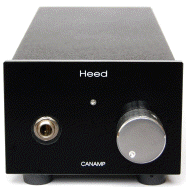
   .gif) .gif) 
HEED
CANAMP II
Listino ufficiale
€. 520,00

Amplificatore in classe "A" per cuffie:
Caratteristiche tecniche: Sensibilitŕ in ingresso/Impedenza: 200 mV/10 kOhm,
Potenza d’uscita: 300 mW (100 Ohm), Rapporto segnale/rumore: (non pesato): 85 dB,
Distortione (THD, 1 kHz, 100mW): <0,05%, Risposta di frequenza: 10 Hz-50 kHz
(±0,5 dB) finitura Nero o Bianco
 Heed
Audio CanAmp Headphone Amplifier Many audiophiles use headphones to enjoy their
system. While some people are compelled to do so by their living circumstances,
others simply prefer cans to loudspeakers. However, some amplifiers either have
no headphone output, just as they don't have phone stages, or if they do have
one, it is often just a simple IC-based stage. Regrettably, even many outboard
amplifiers resort to this simple - and cheap - solution, making it impossible
for headphones to perform at their best. Let us introduce the CanAmp, offering a
no-compromise solution at a realistic price - in fact, given its technology and
manufacturing quality we might even say at a "discount" price.Headphones can be
considered as high quality loudspeakers, but with a much lower power requirement.
For this reason, they have distortion levels an order of magnitude lower than
conventional speakers, and therefore are capable of showing up amplifier
deficiencies more clearly. What's more, headphones are one-way systems, with
very few exceptions, and for this reason crossovers do not interfere with sound
quality. Consequently, a headphone amplifier must offer the best possible sound
quality, even at very low volume levels, whilst working not unlike a real
power amplifier. The CanAmp is a two-stage amplifier. While the first - voltage
gain - stage is based on an integrated circuit of the highest audio pedigree,
the second - power gain - stage is a single-ended, pure Class-A amplifier.
It enables the CanAmp to drive virtually any headphones from 32 ohms up to 600
ohms. The unit has no internal wiring, and the signal path is kept to a minimum
on its PCB. Its high-quality, 1 dB-tolerance Blue Alps volume pot goes through a
further selection process during manufacturing to achieve an even tighter, 0.5
dB tolerance. The CanAmp not only has a line-level input but offers a line-level
output to boot; it can therefore be connected to the TAPE MONITOR output of an
amplifier, leaving the TAPE output free for additional components (MP3, MiniDisc,
CDR, etc.). Gold-plated RCA terminals are used, and soldered directly onto the
fibreglass PCB.Technical specifications Input sensitivity/impedance: 200
mV/10 kOhm Power output: 300 mW (100 Ohm) Signal-to-noise ratio (unweighted):
85 dB Distortion (THD, 1 kHz, 100mW): <0,05% Frequency range: 10
Hz-50 kHz (±0,5 dB) Heed
Audio CanAmp Headphone Amplifier Many audiophiles use headphones to enjoy their
system. While some people are compelled to do so by their living circumstances,
others simply prefer cans to loudspeakers. However, some amplifiers either have
no headphone output, just as they don't have phone stages, or if they do have
one, it is often just a simple IC-based stage. Regrettably, even many outboard
amplifiers resort to this simple - and cheap - solution, making it impossible
for headphones to perform at their best. Let us introduce the CanAmp, offering a
no-compromise solution at a realistic price - in fact, given its technology and
manufacturing quality we might even say at a "discount" price.Headphones can be
considered as high quality loudspeakers, but with a much lower power requirement.
For this reason, they have distortion levels an order of magnitude lower than
conventional speakers, and therefore are capable of showing up amplifier
deficiencies more clearly. What's more, headphones are one-way systems, with
very few exceptions, and for this reason crossovers do not interfere with sound
quality. Consequently, a headphone amplifier must offer the best possible sound
quality, even at very low volume levels, whilst working not unlike a real
power amplifier. The CanAmp is a two-stage amplifier. While the first - voltage
gain - stage is based on an integrated circuit of the highest audio pedigree,
the second - power gain - stage is a single-ended, pure Class-A amplifier.
It enables the CanAmp to drive virtually any headphones from 32 ohms up to 600
ohms. The unit has no internal wiring, and the signal path is kept to a minimum
on its PCB. Its high-quality, 1 dB-tolerance Blue Alps volume pot goes through a
further selection process during manufacturing to achieve an even tighter, 0.5
dB tolerance. The CanAmp not only has a line-level input but offers a line-level
output to boot; it can therefore be connected to the TAPE MONITOR output of an
amplifier, leaving the TAPE output free for additional components (MP3, MiniDisc,
CDR, etc.). Gold-plated RCA terminals are used, and soldered directly onto the
fibreglass PCB.Technical specifications Input sensitivity/impedance: 200
mV/10 kOhm Power output: 300 mW (100 Ohm) Signal-to-noise ratio (unweighted):
85 dB Distortion (THD, 1 kHz, 100mW): <0,05% Frequency range: 10
Hz-50 kHz (±0,5 dB)
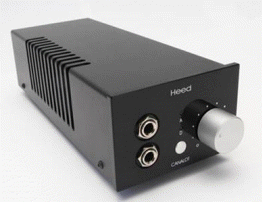
HEED
CANALOT
Listino ufficiale
€. 750,00

Amplificatore di Riferimento in classe "A" per
cuffie con Q-psu: Caratteristiche tecniche: Sensibilitŕ in ingresso/Impedenza:
320 mV/220 kOhm, Potenza d’uscita: 200 mW (32 Ohm), Rapporto segnale/rumore:
(non pesato): 85 dB, Distortione (THD, 1 kHz, 100mW): <0,05%, Risposta di
frequenza: 10 Hz-50 kHz (±0,5 dB) finitura Nero o Bianco. necessita di
alimentatore: X-PSU, Q-PSU o Obelisk PX

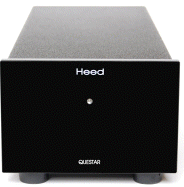
 
HEED
QUESTAR
MM
Listino ufficiale
€. 450,00

QUESTAR MM
Preamplificatore phono MM con possibilitŕ alimentatore separato Q-PSU.
Caratteristiche tecniche: Ingresso: 3 mV/47 kOhm, Risposta di frequenza: 20 Hz -
20 kHz/± 0,3 dB, Guadagno: 42 dB, Rapporto segnale/rumore: 82 dB, Massima
dinamica: 20 dB Separazione tra i canali: 50 dB (1 kHz)
 Heed
Audio QUESTARMM and MC Phono StagesThe QUESTARs are destined to be the MVPs (Most
Valuable Phonostage) of the Heed analogue range. At first glance, they
physically resemble the Pulsar, our previousentry-level MM phono stage, but
looks can be deceiving. Under the hood of their hefty, shielded steel chassis
beats the heart of our award-winning audiophile Quasar MM/MC phonostage,
conveniently divided into neatly-specialized a' la carte portions.The QUESTAR MM
incorporates the Quasar’s unsurpassed MM circuitry. Its sibling, the QUESTAR MC
deploys a streamlined version of the Quasar’s MC stage, eliminating the need for
jumper switches by optimising the amplifier to suit the 300-600 µV output range
characterising the vast majority of today’s moving coils. Considering its
generous 18 dB headroom, ideal cartridge matching is virtually assured.The
internal construction of the QUESTARs meets the most critical high-end standards
in every respect. The amplifier employs an entirely dual-mono configuration and
uses a two-stage - passive/active - RIAA equalisation. Gain adjustment has been
optimised for maximum headroom and highest signal-to-noise ratio. Component
parts are selected to exacting tolerances matching those of our flagship
Quasar.The QUESTARs are suitable for any line-level amplifier input, and can
easily drive virtually any length of interconnect. There is no internal wiring
or binding, and all high-current parts of the circuit are shielded. Both models
feature gold-plated RCA terminals soldered directly onto the PCB, limiting all
signal paths to a bare minimum.The QUESTARs utilise an external “wall-wart”
power supply to avoid undesirable electro-magnetic interference within the
chassis, distinguishing them from their predecessor, the all-in-one-box Pulsar.
Sonic performance can be even further enhanced by upgrading to the Quasar’s
substantial separate box PSU, constructed around a massive 60 VA toroidal
transformer with low-density magnetic field and minimal dispersion. With
substantial 40,000 µF capacitor filtering, the Quasar PSU can feed the QUESTAR’S
circuitry with the kind of super-clean current usually delivered only by
battery-based supplies, even with extreme dynamic swings.Technical
specifications Input: 3 mV/47 kOhm (Questar MM) 220 µV/100ohm (Questar MC)
Frequency range: 20 Hz - 20 kHz/± 0,3 dB Gain: 42 dB (Questar MM) 64 dB (Questar
MC) Signal/noise ratio: 82 dB (Questar MM) 74 dB (Questar MC) Headroom: 20 dB (Questar
MM) 18 dB (Questar MC) Channel separation: 50 dB (1 kHz) Heed
Audio QUESTARMM and MC Phono StagesThe QUESTARs are destined to be the MVPs (Most
Valuable Phonostage) of the Heed analogue range. At first glance, they
physically resemble the Pulsar, our previousentry-level MM phono stage, but
looks can be deceiving. Under the hood of their hefty, shielded steel chassis
beats the heart of our award-winning audiophile Quasar MM/MC phonostage,
conveniently divided into neatly-specialized a' la carte portions.The QUESTAR MM
incorporates the Quasar’s unsurpassed MM circuitry. Its sibling, the QUESTAR MC
deploys a streamlined version of the Quasar’s MC stage, eliminating the need for
jumper switches by optimising the amplifier to suit the 300-600 µV output range
characterising the vast majority of today’s moving coils. Considering its
generous 18 dB headroom, ideal cartridge matching is virtually assured.The
internal construction of the QUESTARs meets the most critical high-end standards
in every respect. The amplifier employs an entirely dual-mono configuration and
uses a two-stage - passive/active - RIAA equalisation. Gain adjustment has been
optimised for maximum headroom and highest signal-to-noise ratio. Component
parts are selected to exacting tolerances matching those of our flagship
Quasar.The QUESTARs are suitable for any line-level amplifier input, and can
easily drive virtually any length of interconnect. There is no internal wiring
or binding, and all high-current parts of the circuit are shielded. Both models
feature gold-plated RCA terminals soldered directly onto the PCB, limiting all
signal paths to a bare minimum.The QUESTARs utilise an external “wall-wart”
power supply to avoid undesirable electro-magnetic interference within the
chassis, distinguishing them from their predecessor, the all-in-one-box Pulsar.
Sonic performance can be even further enhanced by upgrading to the Quasar’s
substantial separate box PSU, constructed around a massive 60 VA toroidal
transformer with low-density magnetic field and minimal dispersion. With
substantial 40,000 µF capacitor filtering, the Quasar PSU can feed the QUESTAR’S
circuitry with the kind of super-clean current usually delivered only by
battery-based supplies, even with extreme dynamic swings.Technical
specifications Input: 3 mV/47 kOhm (Questar MM) 220 µV/100ohm (Questar MC)
Frequency range: 20 Hz - 20 kHz/± 0,3 dB Gain: 42 dB (Questar MM) 64 dB (Questar
MC) Signal/noise ratio: 82 dB (Questar MM) 74 dB (Questar MC) Headroom: 20 dB (Questar
MM) 18 dB (Questar MC) Channel separation: 50 dB (1 kHz)

 
HEED
QUESTAR
MC
Listino ufficiale
€. 450,00

QUESTAR MC
Preamplificatore phono MC con possibilitŕ alimentatore separato
Q-PSU.Caratteristiche tecniche: Ingresso: 0,22 mV/100ohm, Risposta di frequenza:
20 Hz - 20 kHz/± 0,3 dB, Guadagno: 64 dB, Rapporto segnale/rumore: 74 dB,
Massima dinamica: 18 dB Separazione tra i canali: 50 dB (1 kHz)
 Heed
Audio QUESTARMM and MC Phono StagesThe QUESTARs are destined to be the MVPs (Most
Valuable Phonostage) of the Heed analogue range. At first glance, they
physically resemble the Pulsar, our previousentry-level MM phono stage, but
looks can be deceiving. Under the hood of their hefty, shielded steel chassis
beats the heart of our award-winning audiophile Quasar MM/MC phonostage,
conveniently divided into neatly-specialized a' la carte portions.The QUESTAR MM
incorporates the Quasar’s unsurpassed MM circuitry. Its sibling, the QUESTAR MC
deploys a streamlined version of the Quasar’s MC stage, eliminating the need for
jumper switches by optimising the amplifier to suit the 300-600 µV output range
characterising the vast majority of today’s moving coils. Considering its
generous 18 dB headroom, ideal cartridge matching is virtually assured.The
internal construction of the QUESTARs meets the most critical high-end standards
in every respect. The amplifier employs an entirely dual-mono configuration and
uses a two-stage - passive/active - RIAA equalisation. Gain adjustment has been
optimised for maximum headroom and highest signal-to-noise ratio. Component
parts are selected to exacting tolerances matching those of our flagship
Quasar.The QUESTARs are suitable for any line-level amplifier input, and can
easily drive virtually any length of interconnect. There is no internal wiring
or binding, and all high-current parts of the circuit are shielded. Both models
feature gold-plated RCA terminals soldered directly onto the PCB, limiting all
signal paths to a bare minimum.The QUESTARs utilise an external “wall-wart”
power supply to avoid undesirable electro-magnetic interference within the
chassis, distinguishing them from their predecessor, the all-in-one-box Pulsar.
Sonic performance can be even further enhanced by upgrading to the Quasar’s
substantial separate box PSU, constructed around a massive 60 VA toroidal
transformer with low-density magnetic field and minimal dispersion. With
substantial 40,000 µF capacitor filtering, the Quasar PSU can feed the QUESTAR’S
circuitry with the kind of super-clean current usually delivered only by
battery-based supplies, even with extreme dynamic swings.Technical
specifications Input: 3 mV/47 kOhm (Questar MM) 220 µV/100ohm (Questar MC)
Frequency range: 20 Hz - 20 kHz/± 0,3 dB Gain: 42 dB (Questar MM) 64 dB (Questar
MC) Signal/noise ratio: 82 dB (Questar MM) 74 dB (Questar MC) Headroom: 20 dB (Questar
MM) 18 dB (Questar MC) Channel separation: 50 dB (1 kHz) Heed
Audio QUESTARMM and MC Phono StagesThe QUESTARs are destined to be the MVPs (Most
Valuable Phonostage) of the Heed analogue range. At first glance, they
physically resemble the Pulsar, our previousentry-level MM phono stage, but
looks can be deceiving. Under the hood of their hefty, shielded steel chassis
beats the heart of our award-winning audiophile Quasar MM/MC phonostage,
conveniently divided into neatly-specialized a' la carte portions.The QUESTAR MM
incorporates the Quasar’s unsurpassed MM circuitry. Its sibling, the QUESTAR MC
deploys a streamlined version of the Quasar’s MC stage, eliminating the need for
jumper switches by optimising the amplifier to suit the 300-600 µV output range
characterising the vast majority of today’s moving coils. Considering its
generous 18 dB headroom, ideal cartridge matching is virtually assured.The
internal construction of the QUESTARs meets the most critical high-end standards
in every respect. The amplifier employs an entirely dual-mono configuration and
uses a two-stage - passive/active - RIAA equalisation. Gain adjustment has been
optimised for maximum headroom and highest signal-to-noise ratio. Component
parts are selected to exacting tolerances matching those of our flagship
Quasar.The QUESTARs are suitable for any line-level amplifier input, and can
easily drive virtually any length of interconnect. There is no internal wiring
or binding, and all high-current parts of the circuit are shielded. Both models
feature gold-plated RCA terminals soldered directly onto the PCB, limiting all
signal paths to a bare minimum.The QUESTARs utilise an external “wall-wart”
power supply to avoid undesirable electro-magnetic interference within the
chassis, distinguishing them from their predecessor, the all-in-one-box Pulsar.
Sonic performance can be even further enhanced by upgrading to the Quasar’s
substantial separate box PSU, constructed around a massive 60 VA toroidal
transformer with low-density magnetic field and minimal dispersion. With
substantial 40,000 µF capacitor filtering, the Quasar PSU can feed the QUESTAR’S
circuitry with the kind of super-clean current usually delivered only by
battery-based supplies, even with extreme dynamic swings.Technical
specifications Input: 3 mV/47 kOhm (Questar MM) 220 µV/100ohm (Questar MC)
Frequency range: 20 Hz - 20 kHz/± 0,3 dB Gain: 42 dB (Questar MM) 64 dB (Questar
MC) Signal/noise ratio: 82 dB (Questar MM) 74 dB (Questar MC) Headroom: 20 dB (Questar
MM) 18 dB (Questar MC) Channel separation: 50 dB (1 kHz)
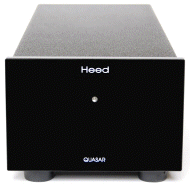
 
HEED
QUASAR
MC/MM
Listino ufficiale
€. 790,00

QUASAR Preamplificatore
phono MM/MC con alimentazione separata Q-PSU. Caratteristiche tecniche: Ingresso
MM: 3 mV/47 kOhm /100 pF Ingresso MC con sensibilitŕ regolabile: 100 μV - 220 μV
- 600 μV Impedenza: 100 Ohm / 220 Ohm / 470 Ohm Voltaggio in uscita: "Bassa
uscita ": 220 mV/100 Ohm "Alta uscita ": 775 mV (0 dBm)/ 22 Ohm *)Alimentatore
non compreso necessita
di alimentatore: X-PSU, Q-PSU o Obelisk PX
 Heed
Audio QUASAR State-of-the-Art MM / MC Phono Stage The signal processing of
cartridges is one of the most delicate jobs in amplification. All the more so
because it isn't done merely by boosting a few hundred microvolts to a few
hundred millivolts. In fact, at this thousandfold amplification (60 dB) the
signal must be processed as cleanly and noise-free as possible. The extremely
low signal level and the frequency-related amplification which arises from the
RIAA equalisation curve applied in the cutting of LPs make the highest demands
of the circuit topology and technical realisation of a phono preamplifier.The
QUASAR, with its discrete conception and wide range of features, represents a
unique bargain at this price level. The QUASAR is built in dual-mono
configuration from the power supply upwards. There are two separate amplifier
stages for MM and MC cartridges, both being fed from their own regulated power
supply arrangement. Optimum adjustments to the cartridge in use can be applied
for sensitivity and load by various settings of the jumpers on the PCB. The two
separate outputs with different sensitivities make it possible for preamps or
recorders to be fed via 'Low Out', whilst its 'High Out' can drive power amps
directly.The output stage has huge headroom at extremely low noise levels and,
due to its low output impedance and high current delivery, can drive long
interconnect cables without any sonic degradation.The enhanced power supply of
the QUASAR is based around a 60 VA toroidal transformer with low-density
magnetic field and very little dispersion. This power, together with 40,000 µF
filtering, can feed the circuit with the kind of super-clean current usually
delivered only by battery-based supplies, even with extreme dynamic swings. The
entirely discrete conception, as well as the short signal paths of the QUASAR,
combine the best audiophile tradition with innovative circuit design. This new
phono preamplifier makes analogue high-end reproduction affordable at last!
Technical specifications MM input: 3 mV /47 kOhm / 100 pF MC input:
adjustable Sensitivity: 100 µV - 220 µV - 600 µV Impedance: 100 Ohm
/ 220 Ohm / 470 Ohm Output voltage: "Low Out": 220 mV/100 Ohm
"High Out": 775 mV (0 dBm)/ 22 Ohm The QUASAR was awarded first prize for
Best Phonostage in 2002 at the biannual "Image Hifi Awards" in Germany,
one of Europe's premier hi-fi accolades. Heed
Audio QUASAR State-of-the-Art MM / MC Phono Stage The signal processing of
cartridges is one of the most delicate jobs in amplification. All the more so
because it isn't done merely by boosting a few hundred microvolts to a few
hundred millivolts. In fact, at this thousandfold amplification (60 dB) the
signal must be processed as cleanly and noise-free as possible. The extremely
low signal level and the frequency-related amplification which arises from the
RIAA equalisation curve applied in the cutting of LPs make the highest demands
of the circuit topology and technical realisation of a phono preamplifier.The
QUASAR, with its discrete conception and wide range of features, represents a
unique bargain at this price level. The QUASAR is built in dual-mono
configuration from the power supply upwards. There are two separate amplifier
stages for MM and MC cartridges, both being fed from their own regulated power
supply arrangement. Optimum adjustments to the cartridge in use can be applied
for sensitivity and load by various settings of the jumpers on the PCB. The two
separate outputs with different sensitivities make it possible for preamps or
recorders to be fed via 'Low Out', whilst its 'High Out' can drive power amps
directly.The output stage has huge headroom at extremely low noise levels and,
due to its low output impedance and high current delivery, can drive long
interconnect cables without any sonic degradation.The enhanced power supply of
the QUASAR is based around a 60 VA toroidal transformer with low-density
magnetic field and very little dispersion. This power, together with 40,000 µF
filtering, can feed the circuit with the kind of super-clean current usually
delivered only by battery-based supplies, even with extreme dynamic swings. The
entirely discrete conception, as well as the short signal paths of the QUASAR,
combine the best audiophile tradition with innovative circuit design. This new
phono preamplifier makes analogue high-end reproduction affordable at last!
Technical specifications MM input: 3 mV /47 kOhm / 100 pF MC input:
adjustable Sensitivity: 100 µV - 220 µV - 600 µV Impedance: 100 Ohm
/ 220 Ohm / 470 Ohm Output voltage: "Low Out": 220 mV/100 Ohm
"High Out": 775 mV (0 dBm)/ 22 Ohm The QUASAR was awarded first prize for
Best Phonostage in 2002 at the biannual "Image Hifi Awards" in Germany,
one of Europe's premier hi-fi accolades.
.gif)
HEED
THESIS
PHI
Listino ufficiale
€. 2.300,00

preampli-fono MM / MC, regolazioni multiple
sia su MM che MC per guadagno e impedenza
 The thesis φ (phi) is a no-compromise phono
preamplifier for all vinyl connoisseurs using a top-class turntable. Just like
the α preamp, it is also fed by the thesis π twin PSU. By using two independent
– MM (moving magnet) and MC (moving coil) – amplifier circuits, it is possible
to use two record players connectedsimultaneously. Cartridge matching is highly
customisable for gain and impedance on the rear panel of the unit by jumpers.
Noise characteristics, dynamic range, headroom and frequency response of the
thesis φ are second to none.
The thesis φ (phi) is a no-compromise phono
preamplifier for all vinyl connoisseurs using a top-class turntable. Just like
the α preamp, it is also fed by the thesis π twin PSU. By using two independent
– MM (moving magnet) and MC (moving coil) – amplifier circuits, it is possible
to use two record players connectedsimultaneously. Cartridge matching is highly
customisable for gain and impedance on the rear panel of the unit by jumpers.
Noise characteristics, dynamic range, headroom and frequency response of the
thesis φ are second to none.

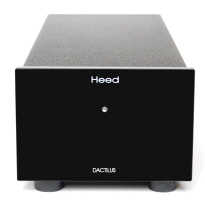
HEED
DACTILUS
Listino ufficiale
€. 699,00

Convertitore Digitale Analogico Ingressi
(S/PDIF,TOSLINK, USB), scheda USB2.0 (Opitonal alimentazione Q-PSU). finitura
Nero o Bianco
 In designing the Heed DACTILUS, our aim was to
create a D-to-A device which makes any digital source – CD players, DAB tuners,
etc. – more enjoyable to listen to in musical terms. Used with higher ranking
digital components it still holds its own against many on-board DACs with its
strikingly different approach – a less analytical and processed presentation of
music which conveys the musical message in a very fluid, natural, rhythmically
engaging fashion. Even the primal Dactilus 1 with our first-ever DAC circuitry,
the Dactil 1.0 module was capable of doing all that: "...it's seldom anything
other than an enjoyable one to listen to and we're happy to recommend it..." as
leading UK Magazine Hi-Fi Choice found it in their 2009 review. The all-new
second generation Dactilus 3, equipped with our new Dactil 1.2 DAC module, is
capable of 24bit/192 kHz high resolution signal processing while extending upon
the virtues of the earlier model, injecting extra transparency, information
retrieval and dynamic capability. The features list is modest: optical (Toslink)
and electrical (Coax SPDIF) digital inputs (selected using a rear-mounted switch)
or an asynchronous, 24bit/192 kHz capable USB input into a single unbalanced
output.
In designing the Heed DACTILUS, our aim was to
create a D-to-A device which makes any digital source – CD players, DAB tuners,
etc. – more enjoyable to listen to in musical terms. Used with higher ranking
digital components it still holds its own against many on-board DACs with its
strikingly different approach – a less analytical and processed presentation of
music which conveys the musical message in a very fluid, natural, rhythmically
engaging fashion. Even the primal Dactilus 1 with our first-ever DAC circuitry,
the Dactil 1.0 module was capable of doing all that: "...it's seldom anything
other than an enjoyable one to listen to and we're happy to recommend it..." as
leading UK Magazine Hi-Fi Choice found it in their 2009 review. The all-new
second generation Dactilus 3, equipped with our new Dactil 1.2 DAC module, is
capable of 24bit/192 kHz high resolution signal processing while extending upon
the virtues of the earlier model, injecting extra transparency, information
retrieval and dynamic capability. The features list is modest: optical (Toslink)
and electrical (Coax SPDIF) digital inputs (selected using a rear-mounted switch)
or an asynchronous, 24bit/192 kHz capable USB input into a single unbalanced
output.

HEED
ABACUS
Listino ufficiale
€. ANNUNCIATO


.gif)
HEED
OBELIX
.gif) .gif) .gif) Listino ufficiale
€. 1.890,00
Listino ufficiale
€. 1.890,00
HEED
OBELIX SI3
/DAC
.gif) .gif) .gif) Listino ufficiale
€. 2.190,00
Listino ufficiale
€. 2.190,00

Amplificatore Integrato Linea con V/RC;
Potenza 2x50W/8 Ω; finitura Nero o Bianco
vinyl-1 Scheda Phono MM per
Obelisk
+ 244,00 euro
DAC 2.3/2.4
Scheda DAC per Obelisk e Thesis + 550,00 euro
 Unleashed
by ION Systems in what only now seems like the twinkling of an eye during the
early 1990s, Richard Hay’s original amplifier concept stirred emotions in Hi-Fi
freaks and music lovers alike. The Obelisk was something unabashedly different.
As Alec Issigonis set the automotive world on its head with his Mini in 1959 – a
groundbreaking design with front wheel drive, transverse engine, sump gearbox,
and phenomenal space efficiency –, so the half-width, shoebox-sized Obelisk
challenged the status quo with its decidedly austere exterior, flexible upgrade
possibilities, and controversial non-DC-coupled topology (by then, largely
considered virtual heresy for any serious transistor-based amplifier). But
above all, it managed to render recorded music, well, disarmingly musical.Like
the metamorphosis of the classic Mini into the ’new MINI’ under the BMW banner
with modern safety, emissions and manufacturing principles, so too we have
resurrected the Obelisk – by applying advanced design solutions, utilizing
superior-quality component parts, and meeting higher production
standards.Therefore, we take tremendous pride in presenting the Heed Audio
Obelisk Si integrated amplifier, its supplementary Obelisk X-2 outboard power
supply, and matching Obelisk PAS stereo power amplifier.This very first 21st
century Obelisk sports 5 line inputs, remote volume control, a beefed-up power
supply, stand-by facility, and the ability to accept either optional phono stage
or DAC modules. And that’s not to mention an entirely re-imagined
preamplifier section based upon, and yet newly refined from our innovative 2-box
Luna preamp. But we have never lost sight of the pivotal principles set forth by
its classic predecessor; the active involvement of Richard Hay throughout the
entire development of the new Obelisk range has been indispensable.Technically
speaking, the Obelisk defies conventional measurement. Mere specifications can
be wildly misleading here. Consider output power: the Si is conservatively rated
at 35 watts per channel into 8 ohms. While this represents a humble enough watt/cost
ratio, here 35 watts don’t exactly equal 35 watts, since the Obelisk’s
non-DC-coupled design behaves rather more akin to valve amplifiers (roughly
speaking, Richard Hay’s approach was sort of a “valve amp built with transistors”)
of similar rating. With this kind of power on board, better valve amps are
capable of astonishing dynamic authority, and we’re more than satisfied that the
Obelisk Si adheres to this paradigm and then some. The Obelisk X-2 power supply
(in fact, a dual-mono power amp PSU) ups the ante to a full 50wpc (again,
behaving more like so many valve-watts), while allowing the original on-board
power supply to dedicate itself entirely to the preamp section. In other words,
with the addition of this single device, the Obelisk Si evolves into a
fully-fledged dual-mono pre/power combination! Finally, the ultimate Obelisk
experience along the Si’s upgrade path is realized by the addition of the
Obelisk PAS stereo power amplifier in bi-amp configuration with compatible
loudspeakers.But perhaps the most distinguishing characteristic of the Obelisk
Si, in any configuration, lies in its inherent and exceptional musicality. With
each listen, we are keenly reminded of how organic and life-like recorded music
can be. But don’t buy this story from us. Just read the verdict of one of
the world’s most distinguished music & Hi-Fi publications, Diapason (France):
„The Obelisk deftly negotiates dense passages with aplomb, yet is always
accompanied by finesse and simplicity, indeed, consider the best tube amps. It
is much closer to the "live" magic of a reference-quality 300B than it really
has any right to. ...The Si’s dynamic range approximates the spontaneity we hear
attending a live performance, evoking the very same impression. A genuine
revelation at a price, after all, without competition.” (And just two short
months after this review was published, the Obelisk Si was named recipient of
the coveted Diapason D’Or Award for 2008.)For even a fleeting experience with
the real world is better than thousand words in hi-fi, do try and meet the
Obelisk wherever you can – trade shows, Heed Audio dealers, happy Obelisk
owners. Unleashed
by ION Systems in what only now seems like the twinkling of an eye during the
early 1990s, Richard Hay’s original amplifier concept stirred emotions in Hi-Fi
freaks and music lovers alike. The Obelisk was something unabashedly different.
As Alec Issigonis set the automotive world on its head with his Mini in 1959 – a
groundbreaking design with front wheel drive, transverse engine, sump gearbox,
and phenomenal space efficiency –, so the half-width, shoebox-sized Obelisk
challenged the status quo with its decidedly austere exterior, flexible upgrade
possibilities, and controversial non-DC-coupled topology (by then, largely
considered virtual heresy for any serious transistor-based amplifier). But
above all, it managed to render recorded music, well, disarmingly musical.Like
the metamorphosis of the classic Mini into the ’new MINI’ under the BMW banner
with modern safety, emissions and manufacturing principles, so too we have
resurrected the Obelisk – by applying advanced design solutions, utilizing
superior-quality component parts, and meeting higher production
standards.Therefore, we take tremendous pride in presenting the Heed Audio
Obelisk Si integrated amplifier, its supplementary Obelisk X-2 outboard power
supply, and matching Obelisk PAS stereo power amplifier.This very first 21st
century Obelisk sports 5 line inputs, remote volume control, a beefed-up power
supply, stand-by facility, and the ability to accept either optional phono stage
or DAC modules. And that’s not to mention an entirely re-imagined
preamplifier section based upon, and yet newly refined from our innovative 2-box
Luna preamp. But we have never lost sight of the pivotal principles set forth by
its classic predecessor; the active involvement of Richard Hay throughout the
entire development of the new Obelisk range has been indispensable.Technically
speaking, the Obelisk defies conventional measurement. Mere specifications can
be wildly misleading here. Consider output power: the Si is conservatively rated
at 35 watts per channel into 8 ohms. While this represents a humble enough watt/cost
ratio, here 35 watts don’t exactly equal 35 watts, since the Obelisk’s
non-DC-coupled design behaves rather more akin to valve amplifiers (roughly
speaking, Richard Hay’s approach was sort of a “valve amp built with transistors”)
of similar rating. With this kind of power on board, better valve amps are
capable of astonishing dynamic authority, and we’re more than satisfied that the
Obelisk Si adheres to this paradigm and then some. The Obelisk X-2 power supply
(in fact, a dual-mono power amp PSU) ups the ante to a full 50wpc (again,
behaving more like so many valve-watts), while allowing the original on-board
power supply to dedicate itself entirely to the preamp section. In other words,
with the addition of this single device, the Obelisk Si evolves into a
fully-fledged dual-mono pre/power combination! Finally, the ultimate Obelisk
experience along the Si’s upgrade path is realized by the addition of the
Obelisk PAS stereo power amplifier in bi-amp configuration with compatible
loudspeakers.But perhaps the most distinguishing characteristic of the Obelisk
Si, in any configuration, lies in its inherent and exceptional musicality. With
each listen, we are keenly reminded of how organic and life-like recorded music
can be. But don’t buy this story from us. Just read the verdict of one of
the world’s most distinguished music & Hi-Fi publications, Diapason (France):
„The Obelisk deftly negotiates dense passages with aplomb, yet is always
accompanied by finesse and simplicity, indeed, consider the best tube amps. It
is much closer to the "live" magic of a reference-quality 300B than it really
has any right to. ...The Si’s dynamic range approximates the spontaneity we hear
attending a live performance, evoking the very same impression. A genuine
revelation at a price, after all, without competition.” (And just two short
months after this review was published, the Obelisk Si was named recipient of
the coveted Diapason D’Or Award for 2008.)For even a fleeting experience with
the real world is better than thousand words in hi-fi, do try and meet the
Obelisk wherever you can – trade shows, Heed Audio dealers, happy Obelisk
owners.

HEED
LAGRANGE
Listino ufficiale
€. 4.790,00
HEED
LAGRANGE /DAC
Listino ufficiale
€. 5.750,00

Amplificatore
integrato, 2x 60 W. 4 input linea. 1fono MM, uscita cuffia classe A, 4 input BT

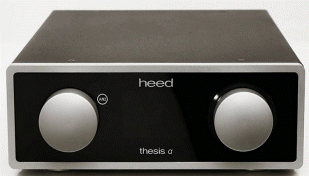
HEED
THESIS
LAMBDA
  Listino ufficiale
€. 3.300,00
Listino ufficiale
€. 3.300,00

Preamplificatore di linea con 2 ingressi
analogici e 4 digitali (S/PDIF, TOSLINK, BNC E USB) con telecomando per ingressi
e volume
 The thesis α (alpha) preamplifier sports two
analogue and four digital inputs including S/PDIF, TOSLINK, BNC and USB. All
inputs, as well as volume setting with muting function are remote-controllable
via our new RC handset. A twin capacitor-coupled output stage caters for driving
long cables and connecting two sets of power amplifiers to drive speakers in
bi-amp configuration. The analogue section of the thesis α is fed by the thesis
π twin PSU which can also supply the φ phono stage with power simultaneously.
The thesis α (alpha) preamplifier sports two
analogue and four digital inputs including S/PDIF, TOSLINK, BNC and USB. All
inputs, as well as volume setting with muting function are remote-controllable
via our new RC handset. A twin capacitor-coupled output stage caters for driving
long cables and connecting two sets of power amplifiers to drive speakers in
bi-amp configuration. The analogue section of the thesis α is fed by the thesis
π twin PSU which can also supply the φ phono stage with power simultaneously.
.gif)
HEED
THESIS
PHI
Listino ufficiale
€. 2.300,00

preampli-fono MM / MC, regolazioni multiple
sia su MM che MC per guadagno e impedenza

.jpg)
HEED
THESIS GAMMA
  Listino ufficiale
€. 3.490,00
Listino ufficiale
€. 3.490,00

Amplificatore finale stereo 2 x 55/90/112 W.
rispettivamente su 8/4/2/ Ohm
.jpg)
HEED
THESIS OMEGA
  Listino ufficiale
€. 3.590,00
Listino ufficiale
€. 3.590,00

Amplificatore finale mono 160 W su 8 Ohm
 The thesis ω (omega) monobloc power amplifier is
an AC-coupled device in true Heed fashion that drives loudspeakers in a similar
way to valve power amplifiers, but without their inherent problems related to
the vacuum tube. Despite certain topological similarities to its valve
counterparts, the thesis ω is best described as a quintessentially solid-state
power amp that successfully gets around the often sterile, lifeless sound of
most solid-state devices. We believe that connecting amplifiers to speakers by
AC- instead of the prevalent DC-coupling results in amuch more natural, less
“cropped” decay of tones. Freed from the cost containments of the Obelisk power
amplifiers, we could achieve a no-compromise implementation of this topology in
the thesis ω. With its very generously sized power supply, unlike valve
amplifiers, it is also extremely stable even into the most difficult loads –
continuous power delivery up to 160W or capability of driving loads down to 1.6
Ohm speak for themselves. It is capable of driving all kind of speakers
except those with very low efficiency
The thesis ω (omega) monobloc power amplifier is
an AC-coupled device in true Heed fashion that drives loudspeakers in a similar
way to valve power amplifiers, but without their inherent problems related to
the vacuum tube. Despite certain topological similarities to its valve
counterparts, the thesis ω is best described as a quintessentially solid-state
power amp that successfully gets around the often sterile, lifeless sound of
most solid-state devices. We believe that connecting amplifiers to speakers by
AC- instead of the prevalent DC-coupling results in amuch more natural, less
“cropped” decay of tones. Freed from the cost containments of the Obelisk power
amplifiers, we could achieve a no-compromise implementation of this topology in
the thesis ω. With its very generously sized power supply, unlike valve
amplifiers, it is also extremely stable even into the most difficult loads –
continuous power delivery up to 160W or capability of driving loads down to 1.6
Ohm speak for themselves. It is capable of driving all kind of speakers
except those with very low efficiency

.gif)

HEED
OBELIX DT
Listino ufficiale
€. 1.890,00

Meccanica CD e HDCD con telecomando;
finitura Nero o Bianco
 The Obelisk DT is a dedicated compact disc audio
transport, reading both conventional and HDCDs, and outputting near-perfect
digital data to any high quality Digital-to-Analogue processor.
The Obelisk DT is a dedicated compact disc audio
transport, reading both conventional and HDCDs, and outputting near-perfect
digital data to any high quality Digital-to-Analogue processor.
We designed the DT to be one of the best value-for-money optical disc players
available. Its uncompromising technical approach, usually found only in
prohibitively-priced transports, makes it well suited for partnering with a wide
variety of DACs, from our keenly priced Dactil 1.2 DAC module (as used
optionally in many Heed components: Obelisk Si, Obelisk PRE, Dactilus) up to
more high-end devices such as our Obelisk DA, the DT's ideal partner. In
an audio market comprised of DACs-galore with dedicated transports
thin-on-the-ground, it is understandable how one might be skeptical of the
significance of CD audio transports, and convinced that D-to-A conversion alone
is responsible for superior digital performance. This misconception can lead
customers to spend huge amounts on DACs for use with modest CD players as
transports, akin to buying very expensive and demanding cartridges for mediocre
turntables. The reality, however, remains inescapable: best data retrieval and
transfer from the source are essential for best possible D-to-A conversion. Of
course, we strongly suggest a serious audition to hear what this exceptional
transport is capable of. If you are a discerning music lover on the lookout for
a truly musical player, even by the highest analogue standards, the Obelisk DT
may well be your ultimate CD-playing device.Specifications:
Supported disc types: CD-DA, CD-R, CD-RW (8, 12cm) Supported audio formats:
CD digital audio, HDCD, MP3 Output format (CD): digital stereo
44.1kHz/16bit S/PDIF Max. consumption: 15W Weight: 3.9kg
Dimensions (WxHxD): 22x8.5x32.5cm

HEED
DELTA CDT
Listino ufficiale
€. 3.250,00
HEED
DELTA CDP
Listino ufficiale
€. 3.590,00

cdt meccanica di
trasporto CD, HDMI uscite digitali coax RCA, ottica, BNC. Possibile montaggio
scheda DAC 2.3

HEED
X-PSU
Listino ufficiale
€. 110,00

Alimentatore
esterno per linea Modular
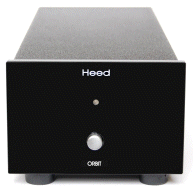
 
HEED
ORBIT 2
Listino ufficiale
€. 670,00

Alimentatore per giradischi a
2 velocitŕ 33/45 giri 220V ( plug "N" play)
 The
speed accuracy and stability of many belt drive turntables driven by a
synchronous motor depends entirely upon the quality/consistency of frequency
delivered by the domestic mains supply. However, mains frequency at 50Hz / 60Hz
leaves much to be desired since it is subject to fluctuation, distortion, and
other innumerable problems prior to reaching your listening room. The Heed ORBIT
1 and Heed ORBIT 2 off-board turntable power supplies offer a sophisticated
solution to stabilise and improve any 4-pole, 110V synchronous motor drive,
elevating your deck's sonic performance to startling new levels of musicality.
Backgrounds become „blacker", separation of instruments more sharply defined,
while bass gains added depth, and the overall soundstage widens accordingly.Both
ORBIT models give the added convenience of electronic speed change between 33
1/3 and 45 RPM via one single, elegant push-button in lieu of the rather fussy
manual speed change arrangement of many turntables (removing the platter and
shifting the belt on the motor pulley time and time again.) The
speed accuracy and stability of many belt drive turntables driven by a
synchronous motor depends entirely upon the quality/consistency of frequency
delivered by the domestic mains supply. However, mains frequency at 50Hz / 60Hz
leaves much to be desired since it is subject to fluctuation, distortion, and
other innumerable problems prior to reaching your listening room. The Heed ORBIT
1 and Heed ORBIT 2 off-board turntable power supplies offer a sophisticated
solution to stabilise and improve any 4-pole, 110V synchronous motor drive,
elevating your deck's sonic performance to startling new levels of musicality.
Backgrounds become „blacker", separation of instruments more sharply defined,
while bass gains added depth, and the overall soundstage widens accordingly.Both
ORBIT models give the added convenience of electronic speed change between 33
1/3 and 45 RPM via one single, elegant push-button in lieu of the rather fussy
manual speed change arrangement of many turntables (removing the platter and
shifting the belt on the motor pulley time and time again.)
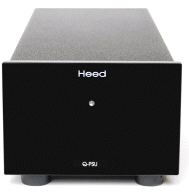
HEED
Q-PSU
Listino ufficiale
€. 530,00

Alimentazione separata utilizzabile per
Questar, Dactilus, Luna II e THESIS ϕ - PHI
 The enhanced power supply of the QUASAR, the
Q-PSU that also can be used as power supply upgrade with other components like
the QUESTAR phono stage or the DACTILUS D-to-A converter is based around a 60 VA
toroidal transformer with low-density magnetic field and very little dispersion.
This power, together with 40,000 µF filtering, can feed the circuit with the
kind of super-clean current usually delivered only by battery-based supplies,
even with extreme dynamic swings.
The enhanced power supply of the QUASAR, the
Q-PSU that also can be used as power supply upgrade with other components like
the QUESTAR phono stage or the DACTILUS D-to-A converter is based around a 60 VA
toroidal transformer with low-density magnetic field and very little dispersion.
This power, together with 40,000 µF filtering, can feed the circuit with the
kind of super-clean current usually delivered only by battery-based supplies,
even with extreme dynamic swings.
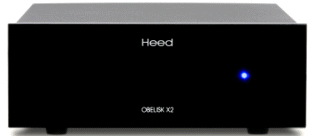
HEED
OBELIX X2
Listino ufficiale
€. 1.190,00

Alimentazione Esterna per Obelisk Si;
finitura Nero o Bianco
The Obelisk X-2 power supply (in fact, a
dual-mono power amp PSU) ups the ante to a full 50wpc, while allowing the
original on-board power supply of the Obelisk Si to dedicate itself entirely to
its preamp section. In other words, with the addition of this single device, the
Obelisk Si evolves into a fully-fledged dual-mono pre/power combination. It is a
substantial technical upgrade, and consequently a leap forward in sonic
performance: it catapults the single-box integrated Obelisk into a much higher
league.
.gif) .gif)
HEED
OBELIX PX
Listino ufficiale
€. 1.190,00

Alimentazione esterna stabilizzata per Obelisk
PRE, Quasar, Dactilus e Canalot; finitura Nero o Bianco
 One of the most difficult tasks we have
undertaken has been to extend the capabilities of the Obelisk PRE, which was
designed to perform beautifully as a self-contained unit. However, the Obelisk
PX dedicated outboard power supply manages to surpass even our highest
expectations. The PX is based on a sophisticated fully-regulated,
double-filtered circuit topology, which eliminates interference caused by the
mains supply, providing the cleanest possible current to the PRE. It features
very high grade components such as a Noratel mains transformer and four 10.000µF
Mundorf capacitors custom made to Heed's own specifications. This results in
extremely low noise, low inner impedance and negligible distortion performance.
Although the PX is primarily designed to partner with the Obelisk PRE, it can
also be paired to enhance the performance of our Quasar phono stage, Dactilus
DAC, Luna II preamp, etc.
One of the most difficult tasks we have
undertaken has been to extend the capabilities of the Obelisk PRE, which was
designed to perform beautifully as a self-contained unit. However, the Obelisk
PX dedicated outboard power supply manages to surpass even our highest
expectations. The PX is based on a sophisticated fully-regulated,
double-filtered circuit topology, which eliminates interference caused by the
mains supply, providing the cleanest possible current to the PRE. It features
very high grade components such as a Noratel mains transformer and four 10.000µF
Mundorf capacitors custom made to Heed's own specifications. This results in
extremely low noise, low inner impedance and negligible distortion performance.
Although the PX is primarily designed to partner with the Obelisk PRE, it can
also be paired to enhance the performance of our Quasar phono stage, Dactilus
DAC, Luna II preamp, etc.
.jpg)
 
HEED
THESIS
PI
Listino ufficiale
€. 2.550,00

Alimentazione Dual per α (Alpha) e ϕ (Phi)
simultaneamente con 2 uscite indipendenti alimentatore per due unitŕ
Thesis, necessario per alimentare pre Lambda e/o pre fono Phi
 The thesis π (pi) twin power supply can feed the
α and φ preamplifiers simultaneously. It has two independent sections, each with
dual regulated power supply rails. In order to ensure an absolutely clean and
stable power delivery, the thesis π uses high-grade components custom made by
Airlink and Mundorf to our specifications, all massively overspecified for
smooth and effortless performance even when pushed to its limits
The thesis π (pi) twin power supply can feed the
α and φ preamplifiers simultaneously. It has two independent sections, each with
dual regulated power supply rails. In order to ensure an absolutely clean and
stable power delivery, the thesis π uses high-grade components custom made by
Airlink and Mundorf to our specifications, all massively overspecified for
smooth and effortless performance even when pushed to its limits

Legenda istruzioni
 Clicca
per qui per vedere : FOTO PRODOTTO Clicca
per qui per vedere : FOTO PRODOTTO
 Clicca
per qui per vedere : ISTRUZIONI PRODOTTO Clicca
per qui per vedere : ISTRUZIONI PRODOTTO
 Clicca
per qui per vedere : CATALOGO,PROVA RIVISTE SPECIALIZZATE PRODOTTO
Clicca
per qui per vedere : CATALOGO,PROVA RIVISTE SPECIALIZZATE PRODOTTO
Nota
bene *
Per ordinare o avere
gli ultimi prezzi aggiornati telefona al
0174 670100
o invia un E-mail a
info@newaudio.it
*I prezzi indicati
sono di listino ufficiale delle case produttrici ,nel
caso di diffusori si riferisce al prezzo del
singolo diffusore per offerte ed eventuali
promozioni telefonare o inviare e-mail.
*Il
presente listino sostituisce ed annulla ogni precedente. Le caratteristiche e i
prezzi indicati possono variare senza preavviso telefonare o inviare un
e-mail per ulteriori domande e conferme sui prezzi sopra riportati.
*Tutti i marchi citati nel presente listino sono di proprietŕ e
registrati alle rispettive Case Produttrici
*Prezzi
franco
nostro magazzino
    

.jpg)

.jpg)
.jpg)
.jpg)
.jpg)
*)Clicca su immagine per accedere a pagina

*)Clicca su immagine per accedere a pagina

*)Clicca su immagine per accedere a pagina

*)Clicca su immagine per accedere a pagina
Audio Video
s.a.s.
Largo Cesare Campana N°2 (stazione ffss)
Mondově 12084 (CUNEO) ITALIA tel.0174 670100 - 0174 300294
C.C.I.A.A. 0169854- P.iva 02335060048
info@newaudio.it
REALISE 42 lite del
1/2023
|